medical link
Cognitive Testing of Senior Doctors

"The proposal to cognitively test older doctors at age seventy is nothing more than ageism."





"The proposal to cognitively test older doctors at age seventy is nothing more than ageism."




Prof Philip Morris AM, President GCMA
MB BS BSc PhD FAChAM (RACP) FRANZCP FPOA FFP ABPN info@drphilipmorris.com | 0422 545 753 | www.drphilipmorris.com

In my President’s Report at this time last year I remarked “as we approach the end of another year I think back over what this year promised. Perhaps the end of the pandemic?” Well, the Covid pandemic is still with us, perhaps in less pervasive form, but still requiring older individuals and those with medical comorbidities to be on the alert and to take all necessary precautions. Younger and healthier individuals need to be aware of what they can do to reduce the risk for more vulnerable members of our community getting the virus. We still have a long way to go before this pandemic is the rear vision mirror.
October saw the last of our monthly clinical/academic meetings for 2022. I would like to thank the speakers and sponsors for our 2022 monthly meeting program – all the topics were very interesting and the presentations of excellent quality. Our program will start up again in February 2023. Due to the ongoing Covid threats from social gatherings for our older members we were not able to hold the planned gala social evening dinner and entertainment function. This event has been postponed to early 2023. We hope to have a lower-key social activity between now and Christmas.
There have been many individuals who have contributed to the GCMA activities in 2022. I would like to thank Marnie Masor for her work as our administrative officer. I would also like to thank my executive committee colleagues for their hard work for the GCMA this year. Dr Maria Coliat, A/Prof John Kearney, Dr Geoff Adsett, Prof Gordon Wright, A/Prof Stephen Weinstein, Dr Cassie Joyce, and Dr Amy Doumany all made sterling contributions. I very much appreciate their support.
In October a group of our executive team (A/Prof Stephen Weinstein, A/Prof John Kearney and I, with our spouses) made a ‘fact-finding’ visit to Apia, Samoa to meet local medical partner organisations to plan a medical conference in Samoa from 2930 September next year. The visit was very successful and we have solid commitments from the Oceania University of Medicine, the School of Medicine of the Samoa National University, the Samoan Medical Association and the Samoan Ministry of Health to join with the GCMA in running this meeting. An article in this The Medical Link provides further information about this very important conference. The GCMA will contribute speakers and presenters for the meeting and we hope the conference will be an opportunity for Gold Coast doctors and their families to visit this
Irritable bowel syndrome (IBS) is a collection of symptoms that occur together, including:
Repeated stomach pain and/ or cramping Changes in bowel movement (constipation, diarrhea)

Urgency
Excessive gas/ bloating.
Once a positive diagnosis of IBS has been made, a dietitian will work with the patient to identify individual food triggers.
FODMAPs are found in everyday foods, including specific dairy products, wheat, other grains, fruit and vegetables
These foods are natural prebiotics and are essential for a healthy gut; these foods also contain essential vitamins and minerals
Elimination Phase (2-6 weeks)
Aims to induce symptoms in order to prepare for individual food challenges.
Reintroduction Phase (6-8 weeks)
Aims to pinpoint trigger foods and identify sensitivity to individual FODMAP subgroups
Personalization (long-term diet)
Aims to liberalise restrictions, expand diet and establish a personalized long-term diet.
L O W F O D M A P D I E T :
wonderful country. The meeting is being held in the Queensland school holiday period in September 2023, so this will also be an opportunity for a family holiday.
The Medical Link is being enhanced with lots of photos of participants at GCMA functions and articles reflecting medical topics presented at our monthly meetings and other topical matters. I would like to thank Aaron Chapman for the extra attention he is putting into our association magazine. We encourage GCMA members to write articles or advertorials for The Medical Link. Contact Aaron on aaron@themedicallink.com.au to make a contribution.
We are always looking to expand our membership. I encourage you to invite your doctor colleagues to join the GCMA. It is very easy to do. Just go to the GCMA website (www.gcma.org.au) and click through to the ‘Become a Member’ page to join. The registration page can take credit card payments. The $150 annual membership is extremely good value. It covers monthly evening meetings where salient updates on clinical and professional matters are presented as well as a two-course meal and complimentary beverage, and the opportunity to interact with colleagues from all professional disciplines.
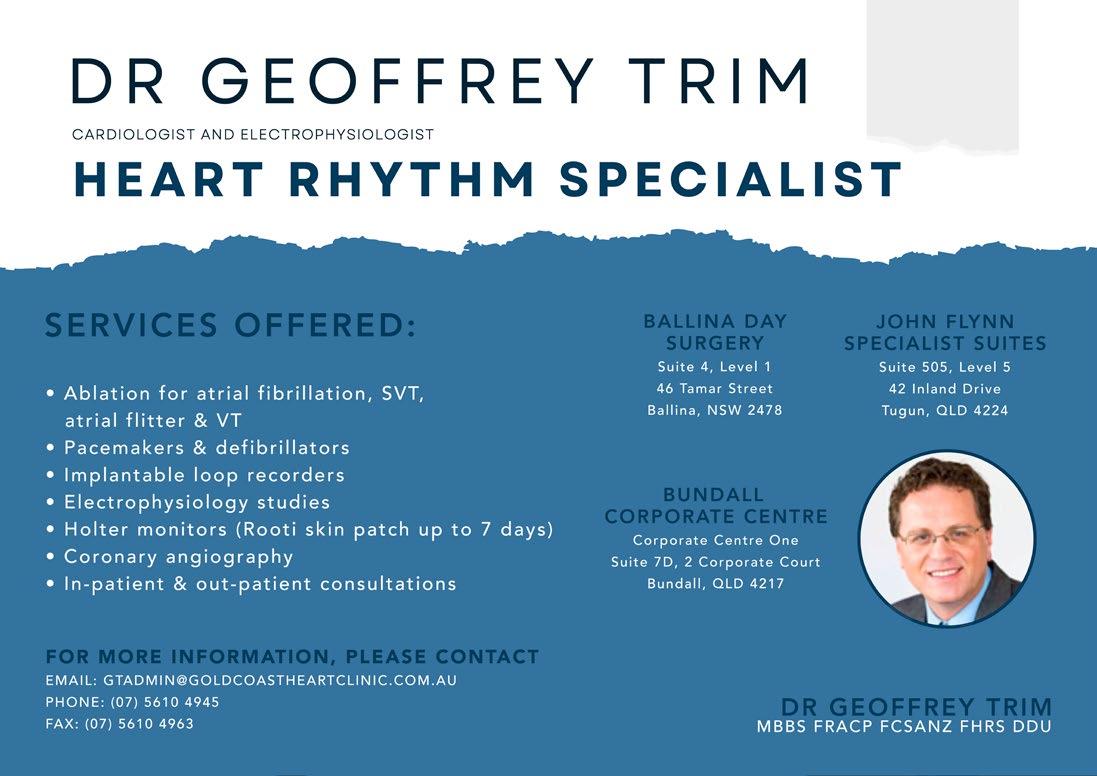

The GCMA is always ready to welcome new members to the leadership team. In particular, we would encourage members to nominate themselves or their colleagues for the positions of secretary, treasurer, vice president, president, Junior doctor representative, GP specialist representative, specialist representative, and academic representative at our next AGM in March 2023. Please give me a call on 0422 545 753 if you are interested.
Finally, I would like to wish all our GCMA members, their families and their friends a Merry Christmas and Happy Holiday Season, and a healthy and prosperous New Year!
Yours sincerely,
Prof Philip Morris AM President GCMA
If you would like to advertise your products or services, positions vacant, rooms for rent etc. in The Medical Link, please feel free to contact us at admin@themedicallink.com.au.
Advertising of medical services in The Medical Link should comply with the same advertising guidelines released in the Medical Board of Australia Code of Conduct:
Be factual and verifiable | Not include testimonials | Only make justifiable claims regarding quality and outcomes | Not raise unrealistic expectation | Not offer inducements | Not make unfair or inaccurate comparisons between your services and those of colleagues
The Medical Link is designed and published by Swan Management Services. It is the advertiser’s responsibility to ensure that advertisements comply with the Trade Practices Act 1947 as amended. All advertisements are published on the condition that the advertiser indemnifies the publisher and its servants against all claims, suits, actions, loss and/ or damages as a result of anything published on the advertiser’s behalf.

DISCLAIMER: The contents of articles and opinions published are not necessarily held by the publisher, editor or the Gold Coast Medical Association. No responsibility is accepted by the publisher, editor or Gold Coast Medical Association for the accuracy of information contained in any opinion, information, editorial or advertisement contained in this publication and readers should rely upon their own enquiries in making decisions touching own interest. Unless specifically stated, products and services advertised or otherwise appearing in The Medical Link are not endorsed by the publisher, editor or the Gold Coast Medical Association.
ADVERTISING advertising@themedicallink.com.au
FINAL DESIGN & LAYOUT Cabin Studio cabinstudio.com.au
DESIGN & CUSTOMER LIAISON design@themedicallink.com.au
PUBLISHER
Swan Management Services admin@themedicallink.com.au
MEDICAL EDITORIAL COMMITTEE
Philip Morris, Geoff Adsett, Stephen Withers, John Kearney, Maria Coliat
GCMA MEMBERS gcma.org.au
GCMA EXECUTIVE COMMITTEE
President Prof Philip Morris 5531 4838
Vice-President Dr Maria Coliat 5571 7233
Secretary Prof Philip Morris 5531 4838
Immediate Past President Dr Sonu Haikerwal 5564 6255
Treasurer Dr Geoff Adsett 5578 6866
Specialist Representative Prof John Kearney 5519 8319
GP Representative Dr Katrina McLean 5564 6501
Academic Representative Prof Gordon Wright 5595 4414
The Medical Link enriches the Gold Coast medical community by uniting the voice of its doctors.
Here you will find insightful stories and the latest trends in field research conducted abroad, and of course, right here on the Gold Coast. Keep informed of new health services, developments in the medical profession, and general interest items.

We invite you to submit your company updates, new recruits and promotions to the following email: admin@themedicallink.com.au
And if you would like to advertise your products or services, positions vacant, rooms for rent etc. in The Medical Link, please feel free to contact us admin@themedicallink.com.au.
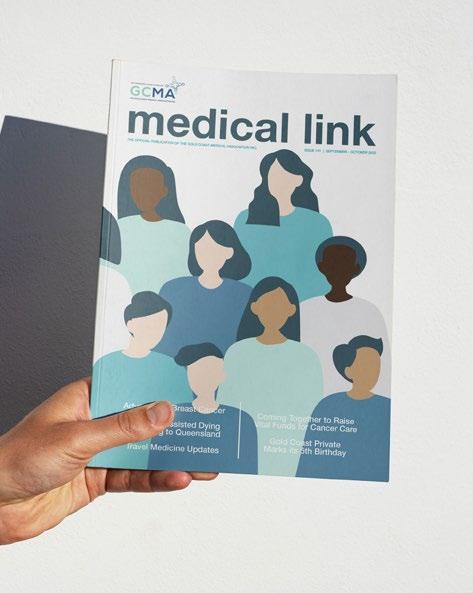









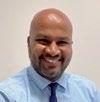


Icon Cancer Centre
Lower Ground 3, 14 Hill Street Southport (07) 5634 2400 | admin.goldcoastprivate@icon.team
October was Breast Cancer Awareness Month. Breast Cancer is the most prevalent cancer and second most common cause of cancer death in women in Australia1. Whilst rare, breast cancer can also occur in males.
Detection of breast cancer while it is still small and confined to the breast provides the best chance of effective treatment for women with the disease2,3. Fortunately, screening can detect breast cancer up to three years earlier than it would be able to be felt by a patient4. Thus, screening for breast cancer is critical to ensure a patient is in the best position to for survival should they develop breast cancer.
The primary screening method to examine for tumours or other breast abnormalities is a mammogram. For breast which is particularly dense, a breast ultrasound (USS) may also be required, and in extenuating circumstances an MRI can be performed.
In Australia, it is recommended screening occurs every two years from the ages of 50 to 74. Women can access free mammograms (every 2 years) from the age of 40, however it is important to note that the incidence of false positives is increased below the age of 50. This may result in unnecessary anxiety for patients, insurance issues and potential over-treatment.
As a result, earlier screening is typically only recommended for patients who present high-risk factors. These include:
• Personal history of breast, ovarian, tubal, or peritoneal cancer
• Ashkenazi Jewish ancestry
• Genetic predisposition with BRACA1 or BRACA 2 mutations
• Family history of breast cancer in first degree relatives
• Higher levels of mammographic breast density
• Early menarche
• Late menopause
• Radiotherapy to the chest between 10 and 30 years of age
To access screening before 50, there must be shared decision between clinician and patient to start screening based on benefit
and harm. It is advised that women aged 75 years and older are only offered screening if their life expectancy is more than 10 years.
If breast cancer is found through the screening process, it is critical patients are given the best possible chance to beat their cancer. There are advanced treatment options available including surgery, chemotherapy, radiation therapy, hormone therapy and targeted therapies.
An experienced multi-disciplinary team (MDT) can help determine the best course of treatment for the patient depending on their individual circumstances, stage of cancer, health factors and treatment preferences.
Dr Mohammed Islam is an experienced medical oncologist who consults and treats patients at Icon Cancer Centre Southport. He is experienced in caring for a wide range of solid tumour malignancies, with a special interest in colorectal cancer, head and neck cancer, lung cancers and urogenital cancers.
For more information or to refer a patient, visit iconcancercentre. com.au/centre/southport, email admin.southport@icon.team or call 07 5657 6400.
1. Australian Institute of Health and Welfare. (2021). Cancer in Australia. Retrieved from https://www.aihw.gov.au/ getmedia/0ea708eb-dd6e-4499-9080-1cc7b5990e64/ aihw-can-144.pdf.aspx?inline=true
2. Centers for Disease Control and Prevention. The National Breast and Cervical Cancer Early Detection ProgramReducing Mortality Through Screening. Atlanta, 2004.
3. Smith RA, Saslow D, Sawyer KA, et al. American Cancer Society guidelines for breast cancer screening: update 2003. CA Cancer J Clin. 2003;53 (3):141-69
4. Centres for Disease Control and Prevention. Is a Mammogram?: https://www.cdc.gov/cancer/breast/ basic_info/mammograms.html
"The proposal to cognitively test older doctors at age seventy is nothing more than ageism."
MB BS BSc PhD FAChAM (RACP) FRANZCP FPOA FFP ABPN info@drphilipmorris.com | 0422 545 753 | www.drphilipmorris.com
Today I wish to discuss the proposal by the medical registration authorities to test the mental capacity of doctors at age seventy in an attempt to improve the safety of health services and to protect the public. I will demonstrate that this proposal is nothing more than the equivalent of racial profiling. I will show that there is no evidence that healthy aging among older doctors is associated with any significant cognitive impairment that would affect patient care. The proposal to cognitively test older doctors at age seventy is nothing more than ageism. Medical boards already have extensive and legitimate powers to assess younger and older doctors who have medical conditions that might affect their cognitive performance and clinical practice. Medical boards do not need to cognitively profile older doctors in order to keep the public safe.
As an empathic exercise, I would like you to think that you are an African-American (black) young man who has gone with his black male friends of the same age to a Southern Baptist Church service on Sunday in the deep south of the United States. After the service is finished, he and his buddies walk back through the city laughing and joking and talking loudly and listening to rap songs on their boom boxes. Everything seems to be going fine until two police cars with sirens screaming turn up. The police officers jump out of their cars and at gunpoint ask the young black males to stand against the wall of a nearby building. The young men ask the police officers why they are doing this. The police officers say that they are going to strip-search them and check them for weapons and drugs because black young males have higher rates of violent
crime and drug use than other Americans. The young men protest that they have just been to Church and are minding their own business and are on their way home. The police are not deterred and proceed to strip search and humiliate them in front of all the other people in the street.
What are the police doing? This is racial profiling. The definition of racial profiling is “any action undertaken for the reasons of safety, security or public protection that relies on a stereotype about race, colour, ethnicity, ancestry, religion or place of origin, or a combination of these, rather than on reasonable suspicion, a singling out of an individual or group for greater scrutiny or different treatment”1
This practice has led to civil unrest in the United States with black Americans feeling that they have been persecuted and discriminated against on the basis of their race. Those who justify this behaviour draw on the argument that although only 13% of Americans are African Americans, yet black offenders (mainly males) commit 52% of the homicides recorded in the United States and the offending rate for black individuals is seven times higher than for whites. FBI records show that 38% of murders were carried out by black offenders to 31% by whites despite the smaller number of black individuals in the United States population2
While some might try to justify the practice of racial profiling with this information, it is generally accepted that racial profiling is just another form of discrimination and racism.
Racial profiling is not fair. Even if the statistics show that young black males in the United States have higher rates of violent crime and drug offending this is no reason to single out a group of young black males walking home from Church on Sunday morning. The only reason that the police could justify the behaviour of stripsearching a group of young black males would be on a ‘reasonable suspicion’ that they might have committed a crime. For example, there may have been a robbery close by and eyewitnesses saw a group of young black males running away from the scene. That would be reasonable suspicion and would justify the police singling out a group of young males. But just being a member of a certain class of individuals is no justification for racial profiling.
You may have now picked up what relevance this might have to medical registration authorities wanting to force seventy-year-old doctors to undergo cognitive testing. The medical authorities are claiming that they are doing this for reasons of safety or public protection. The authorities want to cognitively test all older doctors with a justification built on a stereotype of doctors based on their age rather than on ‘reasonable suspicion’. In this case, we are dealing with ‘age profiling’ rather than racial profiling but the behaviour is just as offensive. Medical authorities in Australia are considering enforcing ‘strip-searching’ the brains of older doctors with cognitive tests based on an age stereotype.
This proposal is nothing more than ageism. Ageism is any attempt to group doctors together as a class based on age and apply ‘special’ rules to the whole class while denying individuals in that class to be assessed on their individual merits or characteristics. This ageism is a reflection of prejudice and discrimination.
While ageism and age profiling of older doctors is totally unacceptable, is there anything that might provide a justification for doing this with older doctors? For example, is there evidence that older healthy doctors as a group have high rates of cognitive impairment that would affect their clinical practice compared with other doctors? In order words, does healthy aging pose cognitive concerns for older doctors practising medicine?
We need to distinguish healthy aging from medical conditions that become more common as doctors age. We know that as individuals get older, they may come into age categories that put them at higher risk of different diseases (Alzheimer’s disease, vascular dementia, ischemia heart disease and cancer, for example). However, we must distinguish these disease states from healthy aging. If a doctor develops a condition of Alzheimer’s disease when they are older, they should be treated in a way no different than if a doctor at the age of thirty-five develops alcohol or methamphetamine dependence and has difficulties in medical practice because of cognitive alterations caused by drug intoxication. The medical registration authorities have the power to intervene in both situations in order to protect the public.

Is there any evidence to suggest that healthy aging in doctors poses a problem for clinical practice?
One way of testing this proposition is to ask the medical indemnity insurers if they have increased or special premiums on their policies based on the older age of doctors. I have investigated this with a number of indemnity insurers in Australia and they assure me that there is no age-related increase in premiums in any of
their policies. Their policies are based on two primary influences. The first is the nature of the practice and the risk profile of that practice and, second, the number of cases that practitioners look after at times in their career (for example, the higher the number of cases as reflected in practice income, the higher the premium). The actuaries that advise the medical indemnity insurers do not advise that older age is an additional risk factor that would justify additional premiums.
Another way of testing this proposition is to identify the age profiles of doctors known to the Health Committees of Medical Boards across Australia. Doctors known to the Health Committees of Medical Boards are generally those doctors who have impairments based on underlying medical conditions. A report from an Australian medical board notes that there is no significant difference in the proportion of doctors over the age of sixty compared to other doctors in the category of doctors known to Health Committees of Medical Boards3
The indication so far is that there is no evidence that healthy older doctors pose a risk to the public that could justify age profiling.
So, what does happen in healthy aging to cognitive capacity over time? There are gradual changes that occur in fluid intelligence and crystallised intelligence4. Fluid intelligence involves cognitive characteristics like processing speed, problem-solving, reasoning, learning new information, short-term memory, executive functions and psychomotor ability. Fluid intelligence peaks in early adulthood and then decline very slowly. These changes are small and gradual. The changes in fluid intelligence are counterbalanced by age-related improvements in crystallised intelligence. Crystallised intelligence involves cognitive characteristics like vocabulary, general knowledge, medical knowledge, experience and pattern recognition (the end product of information acquired), and ‘wisdom’. In healthy aging, the influence of balancing changes in these cognitive qualities usually results in the person not significantly changing in cognitive capacity over time.
As far as I can tell, there is little evidence to suggest that these changes in fluid and crystallised intelligence led to any significant deterioration in the capacity of older doctors to function effectively in clinical practice.
It is important to note that individual variation is substantial in all doctors who age. There is no consensus or agreed on guidelines that help medical authorities decide what level of cognitive changes in doctors due to healthy aging may put the public at risk3. There is little information about how to identify those physicians who are at risk because prospective studies have not been done addressing this issue3
The American Medical Association had earlier agreed that physicians should be tested at the age of seventy years. However, in 2015 they repudiated this decision and now say that "the effect of age on any individual physician’s competence can be highly variable". The American Medical Association has now withdrawn its support of testing physicians cognitively at seventy years of age5
What approaches might be available to medical boards to address the risk to the community of cognitive impairment in older doctors? A recent article on this topic canvassed a number of approaches5 The alternatives are listed below. 1. Reactive 2. Reporting by peers 3. Physician self-assessment & self-report
4. Employer or institutional programs: speciality board recertification/maintenance of certification programs 5. Peer recommendations: credentialing process for staff (re)appointments using peer review 6. Mandatory age retirement 7. Age-mandated cognitive assessments: cognitive testing, direct observation of physician’s practice & work 8. An age-based cognitive screening tool 9. More research
None of these methods is satisfactory and avoids despicable ageism, age discrimination and age profiling. Perhaps the only one I could endorse is ‘More Research’ is needed!
What then is the way forward? Cognitive profiling of the whole profession based on age is not justified on the evidence available. Medical registration authorities have wide powers to evaluate any doctor who is the subject of a complaint or has been notified to them by colleagues or institutions. This capacity applies to doctors of all ages. These authorities do not need to enter into age profiling or age discrimination in order to identify doctors who are having difficulties.
One way of identifying doctors who may be considered to be under ‘reasonable suspicion’ and therefore subject to justified cognitive and health testing would be doctors with two or more complaints made against them in a defined period of time. It is known that the majority of doctors who have health or cognitive problems are ones that have been identified as having multiple complaints made against them – that is many prior notifications or ‘frequent flyers’. This would qualify as a reasonable justification for testing this group of doctors.
In addition, older doctors could also be evaluated for their cognitive and health status after significant lapses in standard of care, but this should be the norm regardless of age and would apply to younger doctors as well as to older doctors.
Finally, it is absolutely vital that all doctors recognise and take seriously their responsibility to identify concerns with their medical colleagues, discuss these concerns with them, and make sure that they get into appropriate care as required.
I hope I have demonstrated in this paper that cognitive profiling of seventy-year-old or older doctors is not justified. A more targeted approach that avoids ageism and age discrimination needs to be developed. I have made a number of suggestions as to how this might be carried out. Further research is required into the best way forward. Discussion between the profession and medical registration authorities needs to examine more respectful ways of identifying older doctors that might be a safety risk to the public.
1. Ontario
https://channel14.com/news/factcheck/factcheck-blackamericans-commit-crime 3. Adler R, Constantinou C. Knowing – or not knowing –when to stop: cognitive decline in ageing doctors. Med J Aust 2008;189(11):622-624.
4. Harada C, Love M, Triebel K. Normal Cognitive Aging. Clin Geriatr Med 2013 Nov;29(4):737-752.
5. Devi G, Gitelman D, Press D et al. Cognitive Impairment in Aging Physicians. Neurol Clin Pract 2021 Apr;11(2):167-174.
Originally published in Samoa Observer
By Sialai Sarafina Saneriviwww.samoaobserver.ws/category/samoa/100171
Aproposal from the Gold Coast Medical Association (G.C.M.A.) for Samoa to host an international medical has been welcomed by the different groups that make up Samoa's health sector.
A delegation made up of executive members of the only local membership-based organisation, which represents the broad interests of the medical community on the Gold Coast, have been in Samoa doing scoping work on whether an international medical conference can be hosted by Samoa.
Following a meeting with all the heads of Samoa's Ministry of Health, School of Medicine and the Oceania Medical Association, the G.C.M.A. executive members have confirmed that an international medical conference will take place in Samoa next year.
In an exclusive interview with the Samoa Observer on Friday, the President of G.C.M.A. Professor Philip Morris confirmed that the conference will run from 28-30 September next year. Other details such as topics and the venue for the conference are yet to be finalised.
Prof. Morris, who is qualified in psychiatry and addiction medicine and is also the Executive Director of the Australian and New Zealand Mental Health Association, told this newspaper they successfully carried out similar conferences in other countries in the Pacific and have built great partnerships with the medical associations of those countries.
They are also hoping to build strong connections and relationships with their colleagues working in the health system in Samoa through this international conference.
Speaking about the objective of the conference, Prof. Morris said they hope the conference will be a "positive and very serious meeting" which covers academic, research and educational topics relevant to the health system of Samoa.
"We are here to see if we can get it all together for September next year," Prof. Morris added.
"We were able to speak with the Samoa Medical Association President, the Dean of the Oceania University of Medicine, the Dean of the National University of Samoa Medical School, the Acting Director General of the Ministry of Health who is also the Deputy Director of Public Health in Samoa.
"We have made expressed our interest with the assistance of the Dean of O.U.M. Dr. Viali who has been our point of contact in Samoa, so far they have welcomed the idea and we are happy to know that they are willing to assist us with making this conference possible."
Dr. Stephen Weinstein added that the people they had met so far in Samoa have been "extremely helpful".
"We appreciate the help from our Samoa counterparts and we are grateful for the support and welcome we have been getting from our colleagues in Samoa."
Asked about how Samoa will benefit from hosting this conference, Dr. Weinstein said that exchanging of ideas at a professional level is the main driver behind the conference.
"We will bring in experts on various fields and we are looking at ways where we can have medical students who are not doctors yet, to work in the hospitals in Australia for training so it can broaden their knowledge and skills maybe that will help them decide what sort of specialty they want to pursue and what sort of specialty Samoa needs.
"We also see this as a learning opportunity not only for the doctors in Samoa but for the doctors from Australia who will be attending this conference."
Nevertheless, Dr. John Kearney Oam, who is an Ophthalmologist at the Gold Coast Eye Clinic, added that this will also help Samoa's tourism sector.
"We have really enjoyed our time in Samoa as this is the first time for the most of us to be in Samoa," Dr. Kearney said.
"We went to a delightful fire dancing at Siva Afi and that was magnificent. We also visited the Robert Louis Stevenson Museum up at Vailima and it was an amazing experience.
"This will also help Samoa in terms of tourism as the conference will bring in doctors with their families and they will get to see what's happening in Samoa and what Samoa has to offer and they can take the experience back to Australia and encourage people to come to Samoa.
"Australians don't understand the nature of things in Samoa and the lifestyle here."
The conference will also be a platform for senior doctors from the two counties to give presentations on the areas that they're looking after.
Not only that, but it will also offer an opportunity for the junior doctors who are also experienced in the profession to present papers to their colleagues.
The O.U.M. Dean for Samoa and the Asia Pacific, Toleafoa Dr. Viali Lameko told the Samoa Observer that the conference will offer overseas specialists to present the latest and updates treatment of some common diseases relevant to Samoan patients and also to health resources and system.
Toleafoa added that this conference will be a great help to medical practitioners in Samoa and is looking forward to the country hosting such an important conference.
"Prostate cancer is a devastating disease in Australia; currently the most diagnosed cancer and second highest cause of cancerrelated death in men1."
Dr Mohammed Islam MBBS, FRACP
Icon Cancer Centre
Lower Ground 3, 14 Hill Street Southport (07) 5634 2400 | admin.goldcoastprivate@icon.team
Prostate cancer is a devastating disease in Australia; currently the most diagnosed cancer and second highest cause of cancer-related death in men1. Adding to this burden, prostate cancer is often asymptomatic until it has reached an advanced stage. September was Prostate Cancer Awareness Month.
Fortunately, screening for prostate cancer can ensure early detection of the cancer when it is at a more treatable stage. However, unlike many other cancers, this may not necessarily correlate with a clinical benefit.
Evidence from randomised clinical research trials suggests that while screening minimally reduces mortality from prostate cancer, it provides no overall survival benefit. Screening may also subject men to both physical and emotional risks, so it is critical the decision to screen is made carefully by both the patient and the clinician.
In Australia, screening for prostate cancer can be conducted annually or every two years from the age of 45. The primary screening method is a Prostate-Specific Antigen (PSA) test. This tests for elevated levels of PSA, a protein produced by normal as well as malignant cells of the prostate gland, in the blood.
Several benign conditions, however, may also cause a person's PSA level to rise, including prostatitis and benign prostatic hyperplasia (BPH). If the PSA test returns positive, a diagnostic biopsy should be ordered to diagnose prostate cancer. This procedure may result in several complications such as pain, infection and bleeding.
The test may also detect cancers that would have caused no symptoms or harm in the patient. The occurrence of false positives and overdiagnosis must be considered as this may result in unnecessary anxiety for patients, health insurance issues and potential over-treatment.
The RACGP recommends against PSA testing as a populationbased screening program. However, there are circumstances where screening can be rationalised. These are typically in highrisk patients who have a:
• family history of prostate cancer
• genetic predisposition with BRACA
• clinical diagnosis of LYNCH syndrome
In such a deadly disease, it is critical patients are given the best possible chance to beat their cancer. If prostate cancer is found, there are many advanced treatment options available including surgery, radiation therapy, cryotherapy, and medical oncology treatments such as hormone therapy, chemotherapy, immunotherapy and targeted therapies.
An experienced multi-disciplinary team (MDT) can help determine the best course of treatment for the patient depending on their individual circumstances, stage of cancer, health factors and treatment preferences.
Dr Mohammed Islam is an experienced medical oncologist who consults and treats patients at Icon Cancer Centre Southport. He is experienced in caring for a wide range of solid tumour malignancies, with a special interest in urogenital cancers, colorectal cancer, head and neck cancer and lung cancers.
For more information or to refer a patient, visit iconcancercentre. com.au/centre/southport, email admin.southport@icon.team or call 07 5657 6400
1. Australian Institute of Health and Welfare. (2021). Cancer in Australia. Retrieved from https://www.aihw.gov.au/ getmedia/0ea708eb-dd6e-4499-9080-1cc7b5990e64/
Icon Cancer Centre proudly presents our fourth annual South East Queensland GP conference, as part of our commitment to delivering the best cancer care possible, as close to home as possible.
With a focus on highly relevant and practical learning, our dynamic two-day program will provide GPs with practical skills that can be readily applied to real-world practice. Topics span across screening and early diagnosis, new treatments and advances, end-of-life care and the future direction of cancer care and haematology.
This year we are proud to offer an exclusive skin cancer workshop with Specialist Plastic Surgeon, Dr Dan Kennedy. This two-part workshop will cover clinical assessment, biopsy techniques and includes a hands-on surgical session to extend your operative skills. Limited spots available!
Don’t miss this exclusive opportunity to connect with leading specialists across Australia’s most prevalent cancers including breast, prostate, lung, skin and colorectal cancers, and haematological disorders.
Scan the QR code or use the link below to register and pay via our secure gateway. Spaces are limited – please register early.

https://qrco.de/IconCPDWeekend2022
For further information please contact the Icon Events team by email cpd.conference@icon.team or phone 07 3347 9560
Please note program and speakers may be subject to change.
Icon Cancer Centres 598125 is an authorised provider of Accredited Activities under the RACGP CPD Program. This activity is pending approval for 40 accredited CPD activity points.
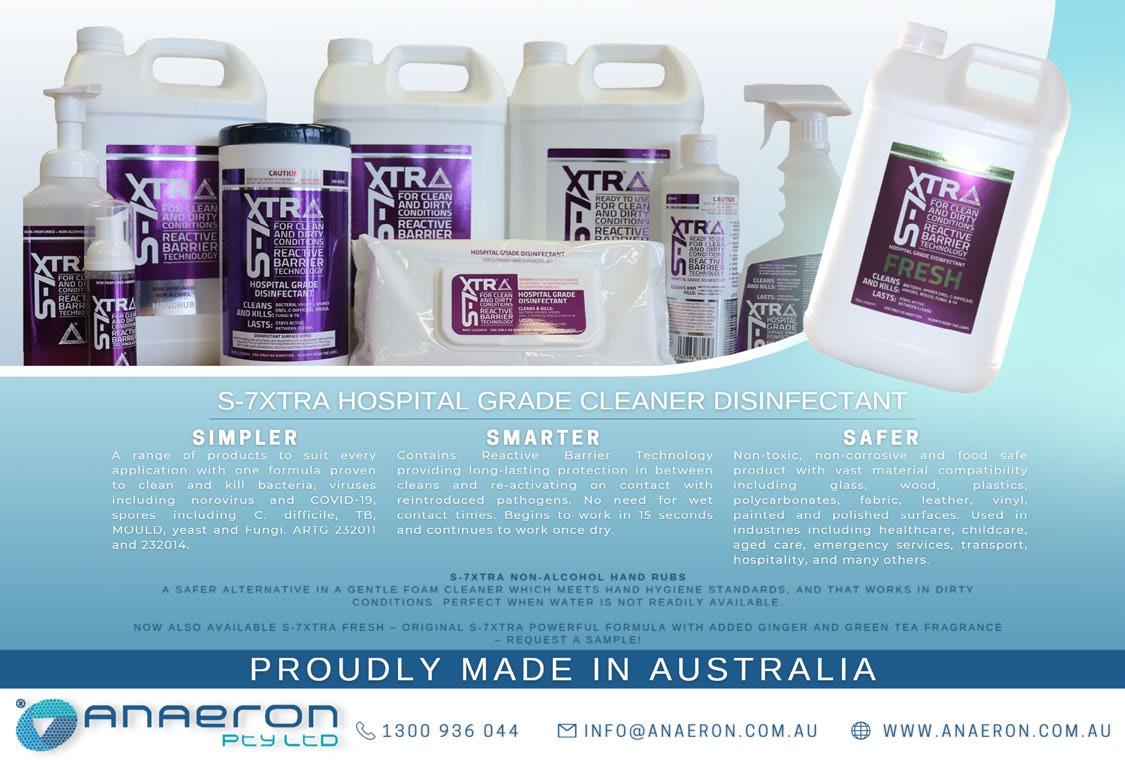
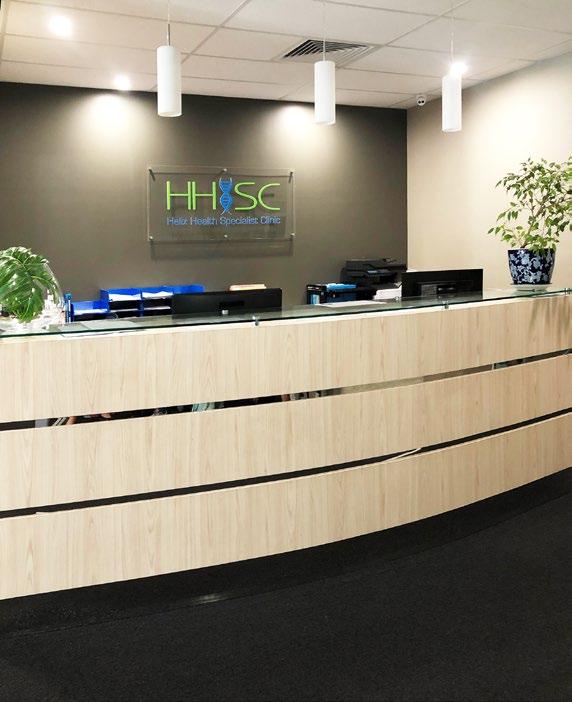
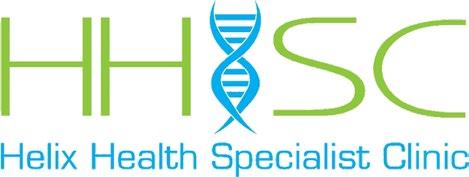

Pregnancy management, birth and breastfeeding

Fertility assessment and pre-conceptual care and optimisation
Heavy, painful and abnormal uterine bleeding
Colposcopy, cervical screening and vulval abnormalities
Contraception and hormonal management
Ovarian cysts and PCOS
Menopause and cancer risk reduction
Dr Priya Sokhal Obstetrician & Gynaecologist



Dr Frances Knight
Dr Anna Alderton Specialist Women’s Health GP Specialist Women’s Health GP















Dr Elise Turner Specialist Women’s Health GP
 Dr Aakansha Zala Endocrinologist
Dr Aakansha Zala Endocrinologist
Avant Mutual support@practicehub.com.au www.practicehub.com.au
With healthcare and employment legislation frequently changing, how do you keep your policies and procedures current to ensure compliance and reduce risk to your practice?
In this article, we’ll cover some of the most common areas of legal risk for your practice and how to ensure you meet the requirements.
Improve your patient recall and follow-up processes
• Lapses in your patient recall and follow-up processes may expose your practice to greater risk of claims and complaints. To improve your processes, consider these ideas:
• With each patient visit, check you have their current contact details, and how they prefer confidential information sent to them.
• Have a mix of recall and notification processes depending on the nature of the test results. For normal results, automated notifications are suitable and efficient, while for serious results requiring urgent follow-up, personal contact is more appropriate.
• In the event of a practice shutdown, power outages, computer systems upgrade, or other business interruption, what is your process for maintaining continuity, data back-up and access, so patient follow-ups still occur?
Making your patient recall system more efficient and accurate is easier using an online practice management platform such as PracticeHub. The software includes policy and procedure templates – including patient recall processes. It provides an audit trail of tasks and team compliance, with a requirement they sign off on reading policies and updates. This helps ensure your practice
systems remain transparent and consistent, because everyone has current information and knows what processes to follow.
This common occurrence is tricky for practices, especially if it arises from a dispute between the parents or when parents are separated or divorced.
A healthcare practice can refuse to provide a parent access to their child’s medical records – although the grounds for refusal are limited, including:
• If providing access poses a serious threat to the life or safety of the patient or someone else
• if it unreasonably impacts on the privacy of others. Particularly if there's information about someone else in that patient’s records (often one of the parents), it's unlawful to disclose that information
• less common grounds for refusal are if the information is legally privileged (e.g. documents in preparation for litigation).
Patient consent should be your first consideration before giving a parent access to records – especially for teenage patients who are considered ‘mature minors’. Legally, a child in this category is considered to have the necessary capacity when he or she reaches a sufficient understanding and intelligence to be capable of making up their own mind in respect of their own treatment and consent decisions.
If you receive a Court order or subpoena requiring production of medical records you are compelled, by law, to produce the
records. Should a parent request a copy of the medical records of their minor child, you would not generally need the consent of both parents before releasing the records, but that could be modified by a Court order. It would be wise to ask the parent/s whether a Court order exists in relation to the disclosure of the medical records of a minor.
If you’re in doubt, call your practice indemnity insurer or Medical Defence Organisation (MDO) for medico-legal advice and how to proceed.

Staying informed on your state’s COVID-safe practices and mandates is an important legal obligation. It’s also important to have policies that meet these mandates around face masks, physical distancing and vaccinations, to keep your staff and patients safe.
As well as satisfying any public health order requirements, your practice may choose to require staff and visitors to be fully vaccinated or to wear a mask as a condition of entry.
The decision is yours, but you do need firm policies around it and ensure that, where vaccination is not a requirement under public health order requirements, such policies are implemented in compliance with applicable consultation requirements under work health and safety laws, so your staff and patients understand your practice’s expectations and to avoid challenges to the validity of your policies.
your practice’s casual employment contracts need updating. A person is a casual employee if they are offered and accept an offer of employment on the basis that the employer makes no firm advance commitment to continuing and indefinite work according to an agreed pattern of work.
To protect your practice from claims for unpaid leave entitlements or other benefits of permanent employment, it’s important to review your new and existing casual employment contracts to ensure you’re paying the current applicable award rates (inclusive of casual loading) and that the terms of your casual employment contracts accord with the new statutory definition of casual employment.
The Fair Work Act also now requires you to give casual employees a Casual Employment Information Statement an additional document to the Fair Work Information Statement you'd be used to giving all new starters.
As part of the recent casual employment legislation amendments, an employer (other than a small business employer with fewer than 15 employees) is now also obligated to assess casuals for eligibility to convert to permanent employment if they have been employed for 12 months, working a regular pattern of hours for at least the last 6 months and could continue working these hours full-time or part-time without significant changes. There is also a ‘residual right’ for an eligible casual employee to request conversion (including casual employees of a small business employer with fewer than 15 employees). There are some exceptions to this, including that you have ‘reasonable grounds’ not to offer, or to refuse, conversion, as outlined in the legislation.
Changes to the Fair Work Act 2009 (Cth) (Fair Work Act) in March 2021 around the definition of casual employment may mean that
It's important to document the steps you’ve taken to assess and offer casual conversion to permanent employment, and your processes for reviewing contracts. PracticeHub makes documenting the process and setting reminders to review work arrangements quick and easy, with centralised access as well. You can also link to the relevant modern awards, so your information is always current and available, as needed, to your whole team.
Review your COVID-safe policies so they meet any mandates
Ensure your casual employment contracts meet recent legislative changes
•
•
•
•

"The technology is so advanced that there has been a substantial reduction in radiation dose administered while still delivering efficient and accurate results."
South Coast Radiology 1300 197 297 www.scr.com.au
South Coast Radiology (SCR) Burleigh Waters delivers a new imaging innovation with the installation of Australia’s first Aquilion Serve CT scanner.
Canon Medical’s Aquilion Serve introduces technology that is designed to set new standards in efficiency and consistency. Created from clinical testing that has refined every detail of the total workflow, it incorporates Advanced intelligent Clear-IQ Engine (AiCE), that dramatically reduces the overall radiation dose while maintaining diagnostic detail.
SCR CT Modality Team Leader Dee-Anne Heaps said the AIbased technology is so advanced that there has been a substantial reduction in radiation dose administered while still delivering efficient and accurate results.
“We introduced our first AiCE scanner six months ago into South Coast Radiology’s new Burleigh Waters site and we have been able to gauge that the technology has reduced our radiation dose by up to 40 percent from the national ARPANSA guidelines,” Ms Heaps said.
“We have 150 radiographers performing 4000 examinations per year and we pride ourselves on maintaining consistent results across all our fleet. It doesn’t matter where the patient gets scanned on any of our Canon scanners, we can optimise our quality and consistency to ensure clear, concise results.”
Ms Heaps said the advantages of the new machine and technology, will allow SCR to increase patient numbers whereby 30 or more can be scanned in any one day without sacrificing overall care.
“The advantage of having Canon scanners across the Gold Coast is that we can provide consistent results no matter the skill level of the radiographer or where the scan is done. This ultimately improves the treatment plan for the patient and the medical outcomes long term.”
SCR’s Radiographer in Charge at Burleigh Waters Gabrielle James said the Aquilion Serve offers an intuitive interface, image quality at low dose and allows radiographers to optimise patient care. She has also seen an increase in productivity at the Burleigh clinic.
“Having worked on other platforms before, I have found Canon simple, easy to learn and use. The automatic scan planning saves me time as the scanner does most of the work for me,” Mrs James said.
“The 3D scanogram allows us to have the SUREStart ready to go without having to do another scan, so that we’re able to pick the slice we need with accuracy. This is great for things like angiograms and CTPAs where we are able to find the actual vessel we need to put it in, and not just guess where we want our slice to be.”
South Coast Radiology has committed to upgrading 70 percent of its fleet to include the AiCE technology which will be rolled out by the end of the financial year.
"A delegation of six, led by Prof Philip Morris, visited Apia to meet with our conference partners."
The GCMA’s previous joint medical conferences in the Pacific were preceded by fairly intense fact-finding visits, and the planned Samoa conference 28 – 30 September 2023 will be no different.

In the second week of October 2022, a delegation of six, led by our intrepid President Prof Philip Morris, visited Apia, the capital of independent Samoa, to meet with our conference partners, select a venue, plan the program, and put in place a steering committee to deal with the numerous details involved carrying out this venture.
First a few words on the Samoan Archipelago, in Western Polynesia. In the 1890s, Samoa was engaged in a prolonged civil war, with the various protagonists supported by the colonial powers Britain, Germany and USA. The issue was resolved in 1899, when the islands were partitioned into American Samoa, which is still ruled by the US, and Western Samoa, which in turn
was ruled by Germany, then New Zealand, and in 1962 became the first independent nation in the Pacific. Independent Samoa is the larger of the two, with a population of about 200,000, while American Samoa has about 55,000. They share the same Samoan language and culture, which is based on the village, and the chiefly system, which places great emphasis on chiefly titles, referred to as matai.
Our conference partners in this venture are primarily the Oceania University of Medicine (OUM), a private medical school headed by its Australian vice chancellor Air Vice-Marshal Prof Hugh Bartholomeusz. Under him there are Deans for Australia, USA and Samoa. Most of the fee-paying students are from Australia and America, and about 15 Samoan students, most of whom are on scholarships. The Dean for Samoa, Toleafoa Dr Viali Lameko, was our main host and contact for this trip. The chiefly matai title “Toleafoa” precedes all other honours.
The other partners are the Samoa Medical Association, the Ministry of Health, and the local Samoan medical school under the National University of Samoa (NUS). We were asked to present at grand rounds at the Tupua Tamasese Meaole Hospital, the main teaching hospital in Samoa. Philip Morris spoke on suicide prevention, John Kearney on traumatic eye injury, and I covered DNA profiling in criminal investigation. The event was well attended by medical students of both schools, registrars and consultants.
My wife Lis and I first taught at the OUM in Apia in 2008, and it was gratifying to be remembered by at least some of the students. One of them is now Samoa’s only psychiatrist. As in many small Pacific Island countries, many of the doctors wear more than one hat, working mostly in the public sector, teaching at the medical schools, and some in the very embryonic private sector.
As far as venues are concerned, the most likely seems to be the Taumeasina Resort, a delightful hotel set on its own small island near Apia, joined by a causeway to the main Island of Upolu. This

place has the best conference facilities in Apia, having recently hosted the Pacific Society of Reproductive Health (PSRH, google it!). During our visit to Apia, the Governor of American Samoa also stayed at the Taumeasina. We did not stay there, but at the Tanoa Tusitala Hotel in downtown Apia, a more central business venue.
Major conference issues still under discussion are the overall theme, topics and speakers, which is where the GCMA members, together with their friends and professional contacts, are indispensable. When asked about what would be most useful to Samoa, the answers encompassed almost the entire spectrum of disease states, from cardiovascular disease, neoplasia, infectious disease (not only Covid!), mental health, trauma, chronic disease, and you name it. It is also likely that the OUM will be looking for elective placements in Australia for some of their students.
If you are interested in being a speaker, please let us know.

Would you like your property portfolio to hit a purple patch?

For over 30 years, our team of lending experts have been assisting medical professionals secure investment home loans tailored to their needs. With a dedicated financial specialist to navigate you through the process and no Lenders Mortgage Insurance, your property portfolio is set to flourish. Plus, for a limited time only, you’ll also pay no application or monthly fees.
So, whether you’re a first-time investor, adding to your portfolio, or refinancing, spring is the perfect time to make a move.
Visit boqspecialist.com.au/invest or speak to your local finance specialist on 1300 160 160.
Credit provided by BOQ Specialist a division of Bank of Queensland Limited ABN 32 009 656 740 AFSL and Australian Credit Licence no. 244616 (“BOQ Specialist”). Terms and conditions, fees and charges and lending and eligibility criteria apply.
*Minimum new borrowing of $500,000.00 with a maximum Loan to Value Ratio (LVR) up to 60%, including a monthly waiver of the home loan fee (currently $10) for the life of the loan and waiver of the home loan application fee (currently $495). These rates are only available for principal and interest investment basic home loans. Not available for the refinance or restructure of existing BOQ Specialist loans, nor refinances from BOQ, Virgin Money or ME Bank, construction home loans or self-managed super fund loans. These rates are indicative rates as at 28 October 2022, and is subject to money market movements and can change without notification. If the rate does change, BOQ Specialist will offer you the most current special rate offer. This offer is exclusive and only available through your direct BOQ Specialist office.
**Comparison rates are calculated on the basis of secured credit of $150 000 over a 25 year term on a 60% Loan to Value Ratio (LVR). WARNING: This comparison rate applies only to the example or examples given. Different amounts and terms will result in different comparison rates. Costs such as redraw fees or early repayment fees, and cost savings such as fee waivers, are not included in the comparison rate but may influence the cost of the loan.
Limited time offer available for new to bank lending application received from 28 October 2022 until 31 December 2022 and settle by 31 January 2023 including a monthly waiver of the home loan fee (currently $10) for the life of the loan and waiver of the home loan application fee (currently $495).